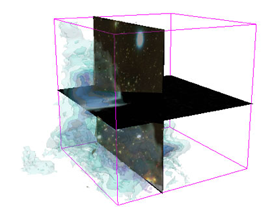Difference between revisions of "Collaboration/Harvard IIC/AstroMed"
| Line 23: | Line 23: | ||
<h1>Approach, Plan</h1> | <h1>Approach, Plan</h1> | ||
| − | Our approach is summarized on the [http://astromed.iic.harvard.edu Astronomical Medicine web site]. The main challenge to this approach is | + | Our approach is summarized on the [http://astromed.iic.harvard.edu Astronomical Medicine web site]. The main challenge to this approach, at the moment, is the impedance mismatch between celestial coordinates and medical imaging coordinates, and a lack of infrastructure within ITK and Slicer to allow for alternative coordinate systems. |
Our plan for the project week is to implement a mechanism that will allow world coordinate system information to travel through the ITK pipeline via an ITK image's metadata dictionary. If we accomplish this, and there is time left over, then we hope to implement bidirectional procedural transforms to map between voxel coordinates and world coordinates. | Our plan for the project week is to implement a mechanism that will allow world coordinate system information to travel through the ITK pipeline via an ITK image's metadata dictionary. If we accomplish this, and there is time left over, then we hope to implement bidirectional procedural transforms to map between voxel coordinates and world coordinates. | ||
Revision as of 18:34, 21 June 2007
Home < Collaboration < Harvard IIC < AstroMed Return to Project Week Main Page |
Key Investigators
- Mike Halle: BWH/Harvard IIC
- Douglas Alan: Havard IIC
- Jim Miller: GE
Objective
We are developing tools and enhancements to ITK and Slicer in order to adapt Slicer to be a tool that is useful for the visualization of astronomical data, specifically spectral line data cubes for now. In order to accomplish this, we need to adapt ITK and Slicer to work with astronomical world coordinate systems.
Approach, Plan
Our approach is summarized on the Astronomical Medicine web site. The main challenge to this approach, at the moment, is the impedance mismatch between celestial coordinates and medical imaging coordinates, and a lack of infrastructure within ITK and Slicer to allow for alternative coordinate systems.
Our plan for the project week is to implement a mechanism that will allow world coordinate system information to travel through the ITK pipeline via an ITK image's metadata dictionary. If we accomplish this, and there is time left over, then we hope to implement bidirectional procedural transforms to map between voxel coordinates and world coordinates.
Progress
We have implemented a FITS reader for ITK. (FITS is the standard file format for astronomical images.) We currently use this reader to convert FITS files into NRRD files so that they can be read into Slicer.
TODO: More stuff here.
References
TODO: Replace the following with our papers.
- Fletcher, P.T., Tao, R., Jeong, W.-K., Whitaker, R.T., "A Volumetric Approach to Quantifying Region-to-Region White Matter Connectivity in Diffusion Tensor MRI," to appear Information Processing in Medical Imaging (IPMI) 2007.
- Corouge, I., Fletcher, P.T., Joshi, S., Gilmore, J.H., and Gerig, G., "Fiber Tract-Oriented Statistics for Quantitative Diffusion Tensor MRI Analysis," Medical Image Analysis 10 (2006), 786--798.
- Corouge, I., Fletcher, P.T., Joshi, S., Gilmore J.H., and Gerig, G., Fiber Tract-Oriented Statistics for Quantitative Diffusion Tensor MRI Analysis, Lecture Notes in Computer Science LNCS, James S. Duncan and Guido Gerig, editors, Springer Verlag, Vol. 3749, Oct. 2005, pp. 131 -- 138
- C. Goodlett, I. Corouge, M. Jomier, and G. Gerig, A Quantitative DTI Fiber Tract Analysis Suite, The Insight Journal, vol. ISC/NAMIC/ MICCAI Workshop on Open-Source Software, 2005, Online publication: http://hdl.handle.net/1926/39 .
